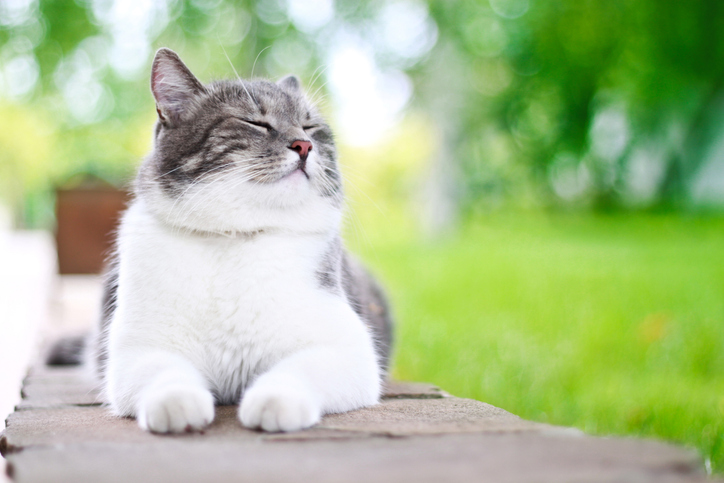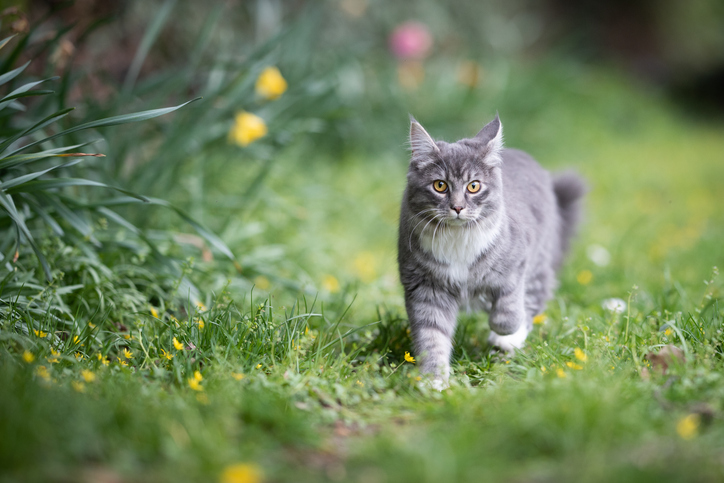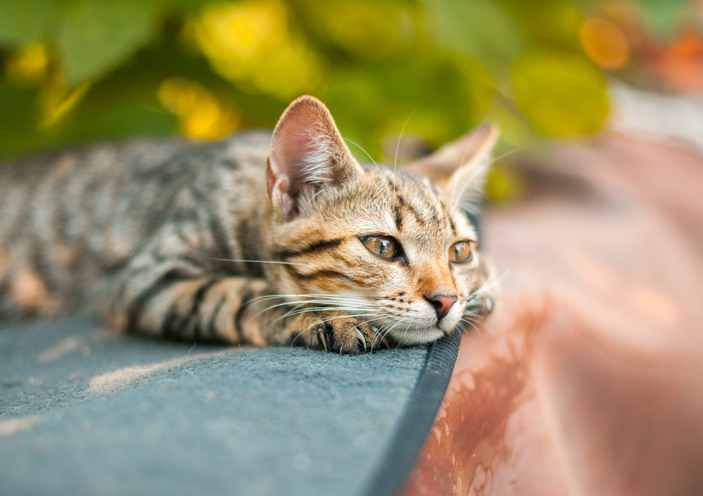
How to cat-proof your garden
7th July, 2022
Cat-proofing your garden is a necessary part of many owners’ household chores. Maybe you need to keep them safe and secure while exploring the outdoors? Or, perhaps you’re having problems with other neighbouring cats trespassing on to your cat’s territory? This can be a particular concern as cats get older and are less able to defend their patch against trespassers.
No matter what the reason, you’ve definitely come to the right place. The caring team at Petwise has put together this invaluable ‘how to’ guide for cat-proofing your garden. We hope you’ll find the right solution both for your garden and your cat's needs.
But remember, whatever the size of your garden or your budget, one of the best things you can do to keep your cat protected is to invest in pet insurance for older cats. Our products are designed with your senior cat in mind. So, you can rest assured your kitty will stay well protected for years to come!
What are the benefits of your cat going out in a garden?
While cats love snuggling up indoors where it’s safe, warm and close to food, many still have an overriding need to get outside regularly.
Creating an enriching outdoor environment for your cat is an important part of responsible pet ownership. And just like arranging pet insurance for older cats it has many benefits.

As well as making them feel safe and secure when they leave the confines of your home it improves their physical and mental welfare. If they’re an outdoor cat then it may also convince them not to wander too far from home. Hopefully reducing the likelihood that they will get into fights, be involved in traffic accidents, or be exposed to other hazards such as illness, disease, parasites and poisons.
Additional benefits of providing a ‘cat-friendly’ garden or outside space could include:
- A less stressed and more relaxed cat around the home.
- Reduced damage or other problem habits because they’re less bored or frustrated.
- More opportunities to engage in instinctive behaviour such as scratching and spraying that you might not appreciate indoors.
- Greater independence and less demanding of your time and attention.
- Having a larger territory to explore with all those new sights, smells, tastes, textures and experiences, will stimulate their natural curiosity and wellbeing.
- Less conflict in multi-cat households. Allowing cats to escape from confrontation or other stressful situations.
- Vermin control. Keeping unwanted rodents at bay in the garden is a time-honoured job of many domestic cats.
- Being free to roam and explore even a limited outdoor space will make them more active and therefore fitter. Particularly if they’re a breed that’s prone to putting on weight.
Be aware it’s not all plain sailing. There are lots of pros and cons when it comes to deciding whether your cat should be an indoors or outdoors puss. Deciding on which is right for you is one of the many questions that you’ll need to consider when you welcome a new furry friend to the family. Cats Protection has an invaluable guide on indoor and outdoor cats that’s well worth a read.
Easy steps to cat-proof your garden
Keeping your cat in and unwanted visitors out
Many owners want to give their cats the benefit of an outdoor life but don’t want them to range too far away from home. One of the best ways to keep your cat within the confines of your home garden, while also keeping other local cats (or predators) out is to install strong and secure fencing or an enclosure. It also needs to be kept in good repair to prevent not only escape but also injury.
Adding cat fencing or a cat enclosure to your garden doesn’t need to take away from the beauty of your garden. Or end up making it look like Fort Knox! There are many options available on the market suitable for all manner of outdoor spaces. From balconies and patios to large gardens, there are many companies capable of designing and fitting such structures.
The charity International Cat Care has a list of reputable companies on its website that are well worth looking through. From ProtectaPet to FeliSafe there are plenty out there. Even if you don’t decide to use one of these, they will provide invaluable inspiration on how you might be able to create and build something yourself.
There are two main choices for securing your garden, patio or balcony for your cat – either a fence or an enclosure. International Cat Care also gives plenty of useful advice on how you can go about constructing these yourself.
An important point to be aware of is the possibility of theft of your family cat. While we’ve grown used to reports of dogs being stolen there are also cases of thieves taking cats, too. So-called cat-napping has risen sharply during the recent pandemic. With data from the police showing the number of cats being taken has risen almost threefold in five years.
As well as securing your garden and getting your pet microchipped it’s also important to arrange pet insurance for older cats. If your pet is stolen or has strayed, insurance cover can help with advertising and a reward for your pet’s safe return.
While fencing or an enclosure are useful, other ways to deter strange cats from trespassing include:
- Watering regularly – Cats hate soggy earth and will avoid such areas.
- Mulching – Covering plant beds with stone chippings, pine cones or other rough materials will put them off.
- Nasty smells – Felines are sensitive to a range of odours. Either from certain plants such as Coleus canina (also known as ‘scaredy cat’) or various other eco-friendly scent deterrents.
- An automatic water spray or ultrasound device – Be careful they’re not positioned so as to affect your own cat.
There are so many potential deterrents on the internet well worth trying out if you have a problem with trespassing cats. Realistically unless you opt for some serious fencing or an enclosure then it’s difficult to completely prevent cats from entering your garden. As a result, it’s always important to have pet insurance for older cats in place, just in case.
Keeping your cat entertained in the garden
If you do choose to cat-proof your outdoor space with fencing or an enclosure, remember you’re limiting your cats' access to vital resources. So, you’ll need to work harder to ensure the outside space remains cat-friendly and contains plenty to keep them happy and well stimulated. Remember, a bored pet is an unhappy pet, which can sometimes lead to annoying and destructive behaviours.
Our top 10 cat-friendly garden ideas worth exploring include:
- Providing places to hide to help them feel safe. These are particularly useful near the entrance to the outside space – such as near the cat flap. When first entering the garden, they might feel nervous. So, it’s great to give them a place to hide while they check if the coast is clear. As well as old wooden boxes or crates, use dense shrubs or other foliage so they can feel like they’re in a den.
- Building features so they can climb up high. Cats love having a good vantage point or perch from which to survey their garden domain. These can also double up as comfortable sunny spots where they can relax, sunbathe and snooze.
- Creating an easily accessible cat toilet from a suitable material such as wood chips, sand or loose earth. Remember to clean it out on a regular basis. After all, cats are fastidious creatures when it comes to toileting. It’s also nice to provide a bit of privacy with a few well-placed plants or shrubs.
- Choosing plants, herbs and other vegetation they can sniff and explore in. Cat lovers should opt for: freesia, greenbell, limonium, olive, pitto, pussy willow, roses, snapdragons, statice, stock, veronica, and waxflower. Not to mention the ever-popular nepeta (catmint) and dactylis glomerata (cat grass).
- Providing shade in hot weather using ornamental grasses or other plants. These also dance and sway in the wind, providing yet more interest. While any plant which encourages insects into the garden is not only good for the environment but will also provide interest for your cat.
- Supplying an all-weather shelter to keep them protected from the wind, rain and cold. Not every cat races inside at the first hint of rain. If your cat enjoys outdoor life then either an old wooden box with a cushion or even a purpose-built cat house could be appreciated.
- Laying a cat-friendly path and lawn. A paved garden path rather than gravel, pebbles or stones is usually best for cats and their sensitive paws. All these materials can easily be swallowed or irritate your pet’s paws. While a soft area of lawn is a great space for your cat to play and stretch, be careful of grass seeds. These can be very painful if they get stuck in your cat’s ears, eyes, nose, mouth, throat or in their paws.
- Making fresh drinking water freely available. Cats need to drink plenty of water, particularly if you’re feeding them dry food. If there’s not enough water in the garden then they’re more likely to try to get out. A shallow water feature can also make an invaluable cooling-off spot on hot summer days – just don’t add chemicals to the water or else you could harm your thirsty cat.
- Something good to scratch on. Cats scratch for many different reasons. And if you want them to be happy in the garden then they’ll need something to do this on.
- Take the toys outside. If your cat enjoys playing with toys then there’s nothing to stop you taking them into the garden. This is a great way to bond with your cat without the need for direct handling. It may also potentially distract them from hunting live-prey, stimulating their predatory instincts whilst directing them away from the local bird population.
If you want even more ideas then read these articles from Battersea Dogs and Cats Home, BBC Gardeners’ World Magazine and gardening specialist Primrose.

Keeping your cat safe in the garden
Outdoor spaces can present many dangers to your inquisitive feline friend and you’ll need to be alert to any potential problems. While having pet insurance for older cats is very useful in an emergency, wouldn’t it be better to avoid the problem in the first place? So, how can you make your garden safer for your cat? Here’s how.
Removing potentially poisonous plants has to be a priority for any green-fingered pet-lover. There is a surprisingly large array of common garden favourites that could poison your pet when they’re out exploring in the undergrowth.
Remember not every part of these plants might be poisonous. And even if your cat doesn’t eat them directly, they could still be potentially very harmful. For example, they might accidentally get toxic pollen on their fur and then lick it off. This is also worth considering when bringing cut flowers into your home.
So, grab your plant catalogue and start checking for some of these common plants that could be a threat to your cat’s health. These include:
- Agapanthus
- Chrysanthemum
- Cornflower
- Crocus
- Cyclamen
- Daffodils
- Dumb cane
- Fern
- Foxglove
- Iris
- Lily
- Lily of the valley
- Marigold
- Periwinkle
- Poppy
- Rhododendron
- Sweet pea
- Yew
- Yucca
Even if you have none of the above, that doesn’t mean you’re safe. The Cats Protection holds a lengthy list that’s well worth consulting if ever you’re in doubt.
And what happens if you decide to introduce some new plants to your garden? Fortunately, the helpful team at the Horticultural Trade Association has created a code that many garden centres now follow when labelling potentially harmful plants. Look out for A for poisonous, B for toxic if eaten and C for harmful if eaten.
Even if your cat has never shown any interest in a plant in all the years they’ve lived in the garden, they might still surprise you. If you have a cat and any of these hazardous plants in your garden then you need to be on the alert. Indeed, it might be wiser to remove the plant entirely and replace it with something entirely cat friendly.
Next, you need to consider how you are currently keeping garden pests under control. While slugs and snails can be a real pain for gardeners, they can pose an even greater threat to cats.
Slugs or snails infected with lungworm larvae can be particularly harmful if eaten. Cats can also become infected with lungworm when they drink water or eat prey infected with the larval stage of the worm. Symptoms to look out for include difficulty breathing, coughing, lethargy and bleeding.
Be aware there are many conditions with similar symptoms to lungworm infection. By investing in pet insurance for older cats you’ll never be worried about giving your vet a call. It’s important to always check with your vet if you notice your cat having coughing fits that just won’t go away or trouble breathing. Don’t let financial worries get in the way of quick and effective treatment for your loyal pet.
While keeping these pests under control is a good idea, you’ll want to avoid using chemical pesticides as these are also highly toxic to pets. There are a wealth of natural alternatives suggested by gardening and nature conservation bodies such as the Royal Horticultural Society and the RSPB.
The best idea we’ve come across is to encourage natural predators like hedgehogs and birds into your garden. Both will happily snaffle up a large supply of slugs, snails and other garden pests.
We all know that cats are very curious and if they see an unsecured shed or compost bin they may well try to climb inside to take a look. But not only can this create a problem for them getting trapped. Such places can contain chemicals, sharp tools and potentially harmful food scraps. That’s why they need to be secured at all times.
While we’re talking about keeping areas well secured, ponds can be dangerous for a cat if there’s no way for them to get out once they’ve fallen in. Avoid any potential tragedy by fencing off your pond or fitting a guard over the top.
And finally, if you suspect your cat has eaten something they shouldn’t have, call your vet straight away. Try to find a sample of what they have eaten in order to help your vet with fast diagnosis and treatment. There are so many different poisons and different reactions that it can be difficult to spot the signs. However, common signs include:
- Excessive salivation
- Vomiting
- Diarrhoea
- Twitching and fitting
- Breathing difficulties
- Collapse and coma
- Skin inflammation
- Changes in drinking, urination and appetite
Never try to make your pet sick or wait to see if symptoms disappear. By having pet insurance for older cats, you’re best placed to get help quickly before matters get worse.
Cats Protection has an excellent guide on poisoning in cats and how to reduce the risks.
Can you walk a cat?
It may sound like a strange question, but did you know dogs aren’t the only pet you can take for a walk? Many owners are now looking into investing in a cat harness and lead in order to safely walk their cats outdoors.
If you do want to have a go then be aware that most cats do not take well to being restrained and won’t accept a harness, particularly if they didn’t wear one when they were a kitten. The Blue Cross animal charity advises against walking cats. But they say that if you do want to then opt for a safe, quiet area away from busy roads and dogs.
Get pet insurance for older cats from Petwise
Whatever the time of year, getting out in the garden together is a fun way to bond with your older cat and keep them fulfilled in their sunset years. But an injury or illness to an older cat can soon get expensive if you haven’t arranged adequate insurance cover.
Pet insurance for older cats from Petwise can give your faithful feline the cover they deserve at a price to suit any owner’s budget. Vets’ fees for accidents, illness or both can be covered from between £2,000 and £10,000, depending on the level of cover you choose.
So, whether your cat is seven or 17, we’re sure to have a policy that suits your budget and requirements. You can choose an excess from £150 per year (per condition), call our 24-Hour Vet Helpline, and speak to our specialist bereavement helpline when the time comes to say farewell to your cat.
Don’t delay, get a quote for pet insurance for older cats today.
Policy benefits, features and discounts offered may very between insurance schemes or cover selected and are subject to underwriting criteria. Information contained within this article is accurate at the time of publishing but may be subject to change.